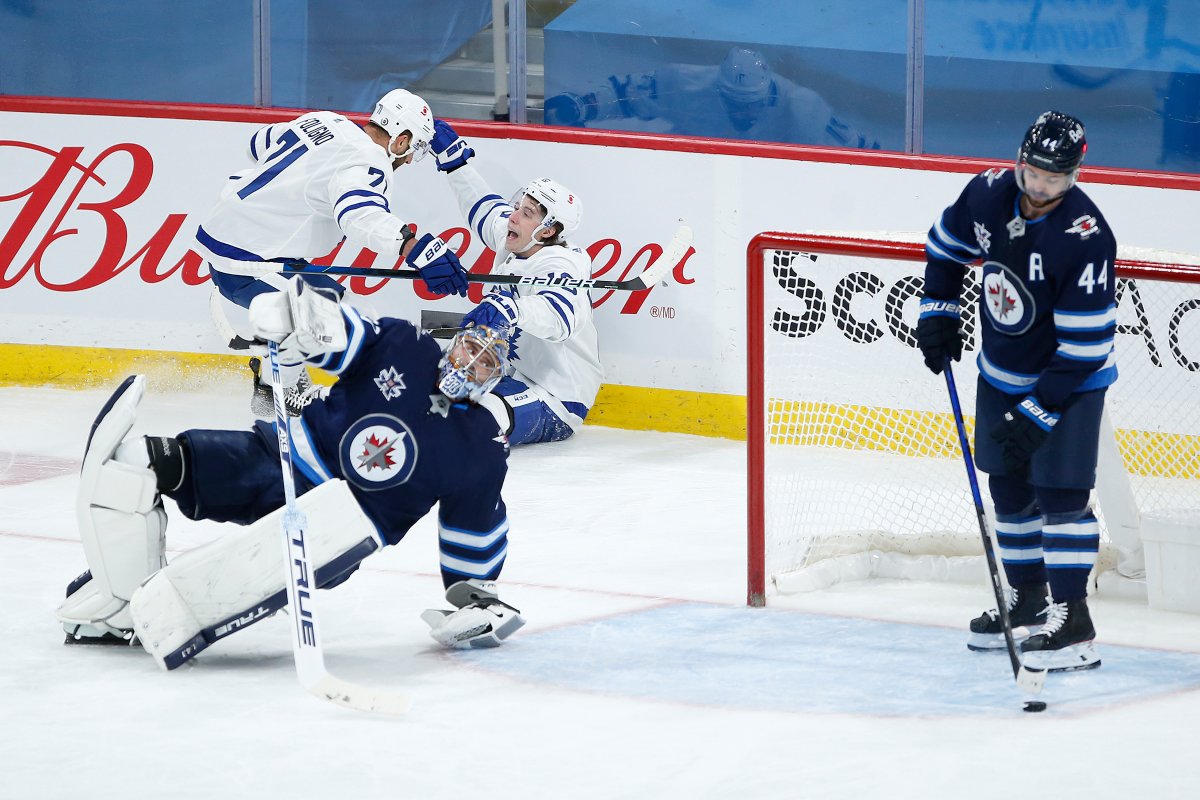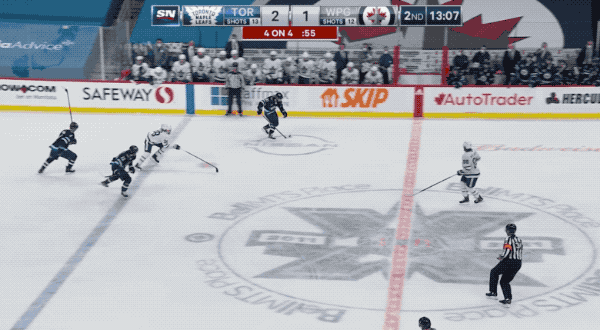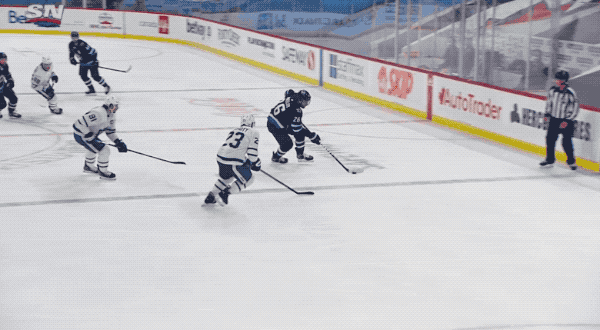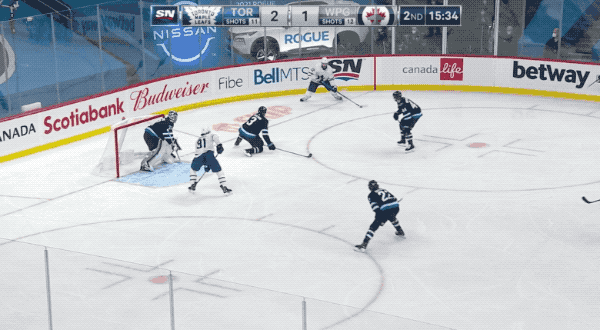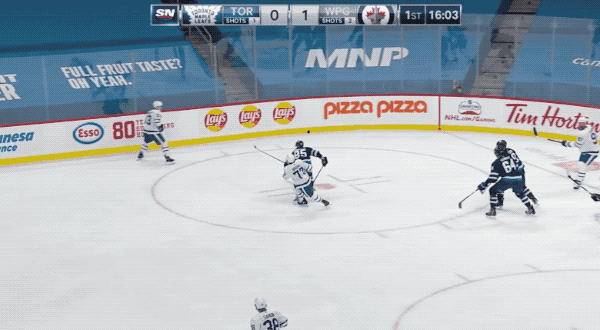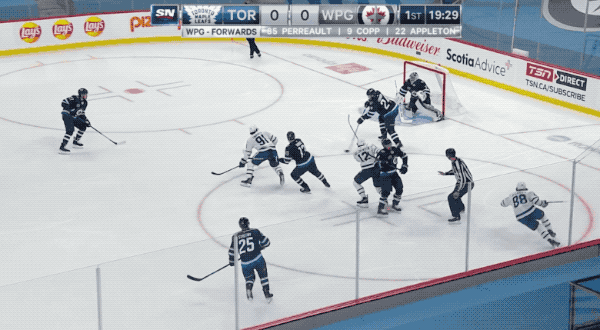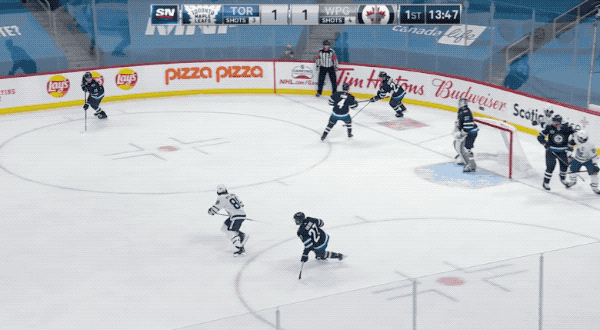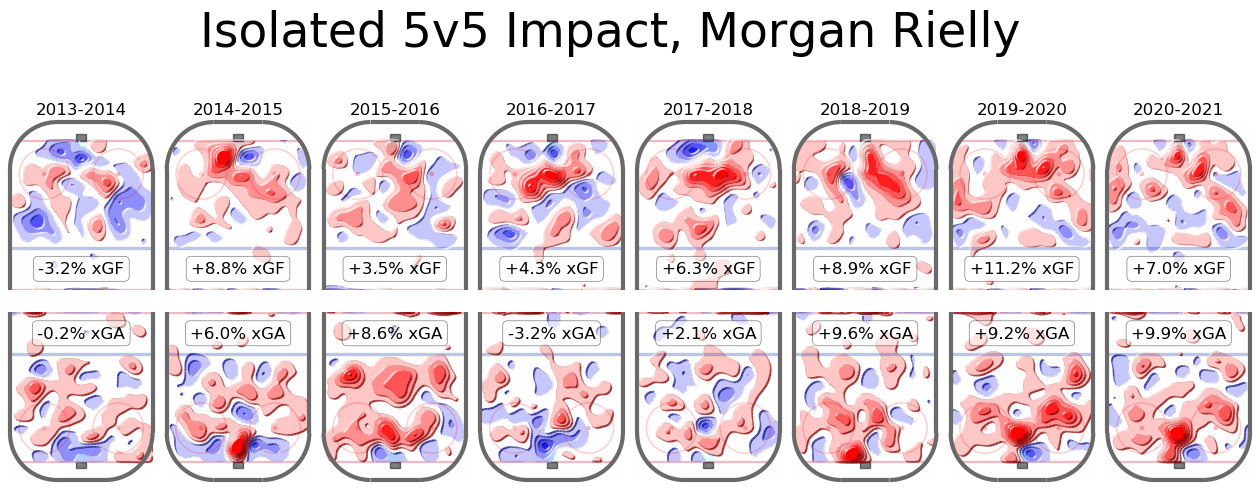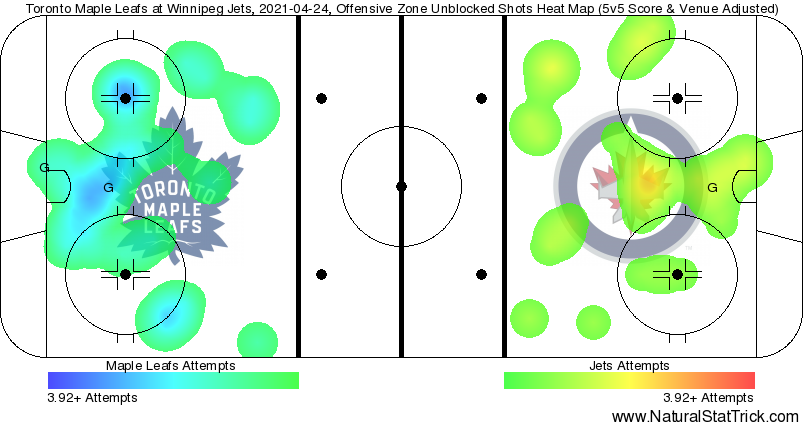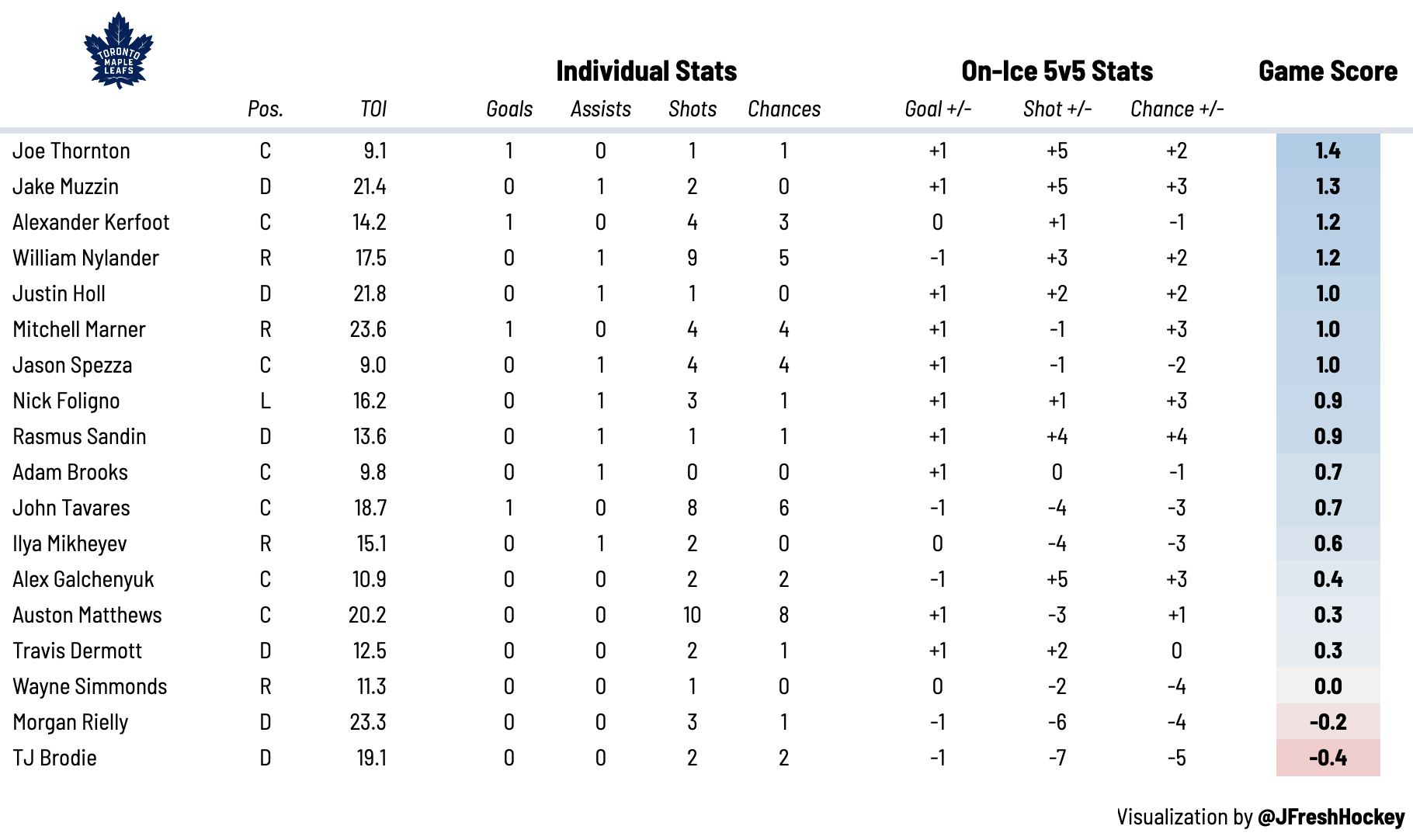For whatever reason, these teams don’t seem to like each other.
When we think of Canadian rivalries, I’m not sure how far down the list we’d have to go before we reached Toronto-Winnipeg, but it’s clearly on the rise! After being called a dirty team by the Jets following their last game, the Leafs followed it up with another physical contest on Hockey Night in Canada.
At the end of the day, Toronto won the game 4-1. More than anything, though, this felt like a playoff game. Both teams were finishing their checks, getting into it after the whistle, and heck, we even saw a Joe Thornton and Nikolaj Ehlers duel. Again, not the rivalry we expected, but certainly one we’ll be paying closer attention to next time around.
With respect this game, let’s dive a bit deeper into the weeds and evaluate how each individual player did. It’s time for some Leafs Report Cards!
5 Stars
Game Puck: William Nylander (RW, #88) — We usually praise Nylander for his zone entries, but it was his defensive play that stood out to me tonight. He did a great job supporting defenders when they needed help low in the defensive zone, most notably Morgan Rielly on a few rush opportunities against.
He also went into Hero Mode at 4v4.
That’s not what I would call textbook positioning from Kyle Connor, but it’s still one heck of a play from Nylander to break up the rush at one end and then get the 2-on-1 pass across for the goal.
He was also doing his thing 5v5, maintaining puck possession on the cycle to help keep the Leafs 200 feet away from their own net.
4 Stars
The Sandin-Dermott Pair — If you’ve watched Rasmus Sandin play at all, you’re well aware that he’s a great passer. The biggest question with him last season was whether he was physically strong enough to handle himself in the tough areas of the ice, especially when he gets stuck out there against the other team’s best players.
I’m sure this helped dispel some of those concerns.
As Kevin Bieksa broke down on the broadcast, Blake Wheeler was not expecting the 5’11, 183lb Sandin to lower the boom with a reverse hit. I’m sure the 6’5 and 225lb Jets captain will approach dump-ins against Sandin differently the next time around.
The rookie defenseman also got an opportunity to run PP1 alongside Toronto’s star forwards, which was fun to see. His partner, Travis Dermott, complemented the pairing well at 5v5. My biggest takeaway was that Dermott got himself involved in the cycle at even strength, activating into the play at the right time and making a quick pass to an open teammate to continue the possession.
He swapped with Adam Brooks a few times, creating confusion for Logan Stanley, who didn’t want to chase the forward out to the blueline, opening up some extra space for the shot to get through. Joe Thornton scooped up the rebound and scored on the wrap-around.
Motion in the offensive zone can be extremely useful when everyone’s on the same page. Here’s another quick example.
In the past, we’ve seen Dermott dump the puck into the corner here and lose possession. Instead, he was looking to be more assertive and complete the “next play” in the passing sequence, which is a nice development in his game.
The Skilled Fourth Line — I get frustrated whenever I hear people say you need “grit” on your fourth line. For my money, this combination of Thornton-Brooks-Spezza has been the most effective 4th line combination for Toronto this season. Now, I guess Joe Thornton qualifies as a gritty player now that he’s insisted on trying to murder Ehlers on every shift.
More importantly, he found the back of the net by controlling play on the cycle and beating Connor Hellebuyck to the far post on that wraparound goal we were just discussing.
This is probably a good time to bring up that Adam Brooks was fantastic once again at 5v5. He gives Toronto’s fourth line some more speed and skill, using it to create space for his teammates both off the rush and off the cycle as you just saw above. That speed also comes in handy on the backcheck, which is where Brooks made a big impact killing plays in the neutral zone.
I was debating not including Jason Spezza in this section because his linemates outplayed him tonight, but his presence as a passer and crafty zone entry wizard can’t be ignored. These three play really well together with their ability to pull off quick passes, which is why I’d keep them together moving forward.
Jake Muzzin (LD, #8) — Productive toughness is something I care a lot about, especially for a defensive presence like Muzzin. Too often we’ll hear NHL GMs praise guys like Erik Gudbranson or Mark Borowiecki, who body check opposing forwards after they’ve moved the puck.
Unlike those brutes, Muzzin uses his physical advantage to push players off the puck and regain puck possession. For example, tonight he activated into the play below the goal-line and found himself in a 50-50 battle with Dylan Demelo. He swiftly pushed Demelo aside, grabbed the loose puck, and completed the next pass.
Muzzin also picked an assist on a flukey goal off of the stanchion and onto Mitch Marner’s tape for an empty netter. It was one of those plays that proves hockey is completely random, although it was nice to see Muzzin get rewarded on the scoresheet for his strong play without the puck.
Coaching Staff — There were a lot of interesting wrinkles in this game.
- Sandin getting an opportunity on PP1
- Matthews-Tavares-Nylander with Rielly-Sandin for an OZ draw after a PK
- Spezza on PP1 for a right-side draw with 10 seconds left, which is a smart way to take advantage of his faceoff ability
- The power play actually looked good tonight
When you throw in the fact that the Leafs tilted the ice in their favour again at 5v5, I feel compelled to tip my hat to Sheldon Keefe. He’s got this team playing at a high level right now throughout the lineup.
Jack Campbell (G, #36) — It’s hard to knock him too much for giving up the first goal considering it was a backdoor saucer pass that Ehlers immediately roofed. After that, Campbell was perfect, stopping the next 25 shots that came his way, earning him a .962 save percentage for the night.
The Leafs did a good job of limiting shot quality for the most part, but Campbell still needed to come up with a few big saves, most notably on Paul Stastny following a DZ turnover and Josh Morrissey on a PP slap shot. Campbell also took an Ehlers clapper to the mask and looked a little shaken up afterward, so that might be something to keep an eye on.
3 Stars
The Matthews-Marner Combo — These two have been stapled at the hip all season, so why not grade them together tonight? Auston Matthews and Mitch Marner pulled off a few nice give-and-go plays together, but when the puck made its way onto Nick Foligno’s stick, there was a noticeable drop-off offensively. That isn’t Matthews or Marner’s fault, but if this is a line the Leafs want to work, they’ll need to find a way to keep buzzing in the OZ alongside a puck-retriever, much like they have with Zach Hyman in the past.
As we mentioned earlier, Mitch Marner was gifted a goal after a weird bounce off the glass, helping him pad his stats a bit there. He also probably should’ve added an assist on either one of the backdoor passes he made to William Nylander on the power play, but it wasn’t meant to be.
Sometimes you get lucky (weird bounce off the stanchion) and sometimes you get unlucky (slap-pass off the crossbar). That’s hockey for you, folks.
John Tavares (C, #91) — This wasn’t his most dominant night offensively, although he did finish the game with six chances from the slot, ranking second on the team tonight behind Matthews’ eight. Tavares’ best play of the game actually came on the backcheck, following Rielly’s turnover on the power play. It looked like Winnipeg was going to convert on the ensuing 2-on-1, but Tavares got back just in the nick of time to break up the play.
Alex Galchenyuk (LW, #12) — I’ve re-watched this goal too many times to count.
I’ve heard some people argue that Rielly needs to be more aware of the backdoor saucer pass. Others have pointed out that Galchenyuk stops moving his feet at centre ice. If he keeps pushing, can he get to Ehlers in time? The honest answer might be “no” and we just conclude it was an awesome pass.
The reason I dive so deep into these defensive miscues is because they’re going to dictate whether or not Toronto’s coaching staff will be willing to trust Galchenyuk in the top six come playoff time. Both the Matthews and Tavares lines are clicking above 60% in expected goals when Galchenyuk shares the ice with them at 5v5, but there are also some troubling signs you could see rearing their ugly head in a high-leverage game.
Personally, I’d like to see Galchenyuk stay in the top six since it would allow the Leafs to play a Hyman or Foligno on a third line that suddenly becomes much more effective. In order to do that, though, the Leafs need to be willing to trust their reclamation project defensively, which is becoming more and more difficult these days.
Justin Holl (RD, #3) — My notes on Holl after every game tend to look similar: “Good stick…managed to get his stick on the puck…good 1v1 rush defense on Ehlers, good stick.”
Whenever you hear NHL head coaches talk about defense, they’re obsessed with stick positioning. Getting sticks in the right spot; sticks in lanes; having an active stick; a “good stick” – what the heck does that mean? To sum it up quickly, it means getting yourself in the right position so you have an opportunity to get your stick on the puck and break up the play.
Holl has a knack for this, which isn’t the sexiest part of being an NHL defenseman, but it’s a crucial one.
Wayne Simmonds (RW, #24) — I’ve given Simmonds a hard time this season when it comes to making plays with the puck on his stick, which is why I feel the need to commend him when he has a good showing in that department. There were a few times he scooped up loose pucks, made a quick play, and then drop-passed it to Alex Kerfoot in a great shooting position.
Simmonds also got into it, verbally, with Pierre-Luc Dubois towards the end of the game, with both players earning themselves a “go home before things get out of hand” misconduct late in the third period. I’ve handed those out before as a ref, albeit to a few hot-headed teenagers in house league hockey. It was a nice reminder that the beef between these teams is real, which is something I’m sure Leafs fans love from their heart-and-soul players.
TJ Brodie (RD, #78) — His pairing got shelled at 5v5, but shockingly, I’m of the opinion you can pin most of that on Rielly. We’ll address more of that in his section, but Brodie is often put into a no-win situation and still manages to find a way to make a good play. He did a great job starting the breakout, shedding the first forechecker before delivering a crisp pass up the ice.
As a side-note, Brodie was awesome at 4v4, teeing up Matthews for a quality chance and even earning one of his own in the slot. We obviously care more about 5v5 play when we’re evaluating hockey players, but it’s nice to know Brodie maintains his effectiveness when there’s more open ice.
2 Stars
Nick Foligno (LW, #71) — The other night I joked that I was Buzz Killington for criticizing the play of Foligno (and Sandin) when most Leafs fans were thrilled with their performance. I’ll happily play that role again because, frankly, I didn’t think Foligno played that well tonight.
There were defensive aspects I liked (i.e. covering for Rielly as the F3), not to mention a few nice board battles. The biggest issue is that plays were dying on Foligno’s stick. Matthews and Marner would be in the process of creating something dangerous, the puck would find its way to Foligno, and he’d rim it around the boards to an opposing Jets defenseman.
I still think Foligno can make an impact in Toronto’s top six — this was only one game — but tonight does make me wonder if he’s the greatest fit alongside Matthews-Marner. Considering Foligno’s game is largely built on the cycle, I’d like to see what he looks like with Tavares, who spends most of his time working out of tight spaces in the OZ.
Can they succeed without top-six linemates? — The results this season will show you that Ilya Mikheyev and Alex Kerfoot have been getting buried at 5v5 when they play without top-six talent. Mikheyev hasn’t been able to accomplish much without Hyman, while Kerfoot’s numbers plummet when he’s on the ice with anyone not named Tavares or Nylander.
It’s nice to see Mikheyev make an impact with his speed on the PK, but at even strength, I’m starting to get worried about these two. They each picked up a point on an empty-net goal, where the Soupman hilariously hit the side of the net on a 4v5 rush — because what else would he do? — but then made a nice play out front to ice the game.
Getting back to the 5v5 concerns, I’m starting to wonder if both players are in your top 12 when everyone is healthy. They obviously provide some defensive value and chip in on the PK, but at even strength, they’ve both struggled this season.
1 Star
Morgan Rielly (LD, #44) — Shortly after the Ehlers goal that had Leafs Twitter up in arms about whether to blame Rielly or Galchenyuk, this happened.
For all the Rielly truthers out there, I’d love to hear a logical explanation for plays like these, which tend to happen way more often than they should. There’s no reason for him to lose his man in behind him here.
For everything he creates offensively, he gives it right back on defense, which has been the trend over the last three seasons.
Data from HockeyViz.com
If my goal is to be objective here, I just don’t think he’s as good at impacting play at 5v5 as his reputation suggests. He’s obviously a talented offensive player with the puck on his stick, but if you ever iso-cam him when the Leafs don’t have the puck, there are still some major flaws in his game that lead to rush opportunities against.
Heat Map
Here’s a quick look at where each team’s shots were coming from at even strength, courtesy of Natural Stat Trick.
The Leafs controlled 55 percent of the shots and chances at 5v5, even though this isn’t exactly the most colourful heat map we’ve seen this season.
Game Score
Game score is a metric developed by The Athletic’s Dom Luszczyszyn to measure single-game performance. You can read more about it here.
Tweets of the Night
These are the kinds of passes the Leafs' power play needs to make. Quick ones. pic.twitter.com/NMHfUsXW1M
— Omar (@TicTacTOmar) April 25, 2021
Toronto’s power play looked more dangerous tonight than it has in a long time, thanks in large part to quick, unpredictable puck movement.
It also helps to have a fifth skill guy out there.
Nylander's combination of clever movement and skill in tight should make him a lock for the net-front role on PP1. They look so much better with him there, and that's not even mentioning his zone entry skills.
— Arvi (@arvi) April 25, 2021
I don’t think it’s a coincidence that the Leafs’ passing at 5v4 has been much quicker with Nylander on the ice. His puck-skills give them another option to gain the zone, and once they get in, he can make passes that a Simmonds or Hyman just can’t.
Tavares on Sandin: "You see he's going to be a real special player for us, not only now, but what he's going to continue to evolve into." #Leafs
— Terry Koshan (@koshtorontosun) April 25, 2021
This has been the most fun part of watching Leafs games lately.























